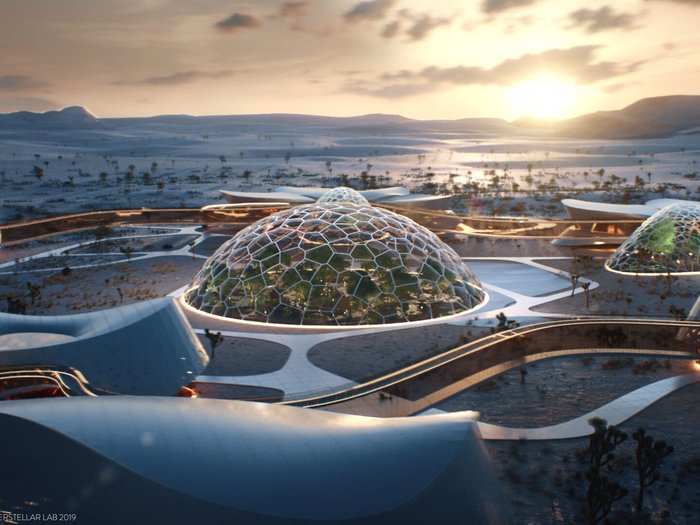
"The two planets share a common ground," Barbara Belvisi, the company's CEO, said in a statement. "What we need to bring on Mars for life is what we need to protect on Earth right now."
The idea is just a proposal for now, but Belvisi has identified four potential locations in the Mojave desert. She told Venture Beat that she is negotiating on a property and expects to finish that process in February.
Belvisi also said she intends to raise funding for the colony's construction.

The stations would also come with living spaces, an art and music center, and research laboratories.

The entire compound is designed to be carbon-neutral with zero waste. Water, food, and energy would get recycled and reused so that inhabitants could live entirely off-grid.

That cost still needs to be finalized, however. The company expects astronauts to inhabit the colony for half the year. During the other half, tourists could book a stay in one of the colony's living spaces.

The Mojave Desert is arid and desolate, but its temperatures are much higher than the red planet's.
The average temperature on Mars is minus 80 degrees Fahrenheit. In the winter, temperatures can drop to minus 195 degrees Fahrenheit.

In the early 1990s, a set of enclosed biomes and living spaces in the Arizona desert, called Biosphere 2, housed four men and four women. The goal was to to see how humans might survive in outer space. The group lived inside for two years and attempted to be fully self-sustaining.
Over the course of that experiment, however, food became scarce and oxygen levels in the community dropped (partly because organic matter in the soil promoted the growth of oxygen-hungry bacteria). By the end, the residents had divided into factions and some were barely on speaking terms.
Belvisi told Venture Beat she has spoken with the experiment's alumni to learn how to avoid these issues.

"A long-term, sustainable Mars or lunar settlement will only be practical if we do the research on Earth," Greg Autry, the former White House Liaison at NASA, said in a statement.
Interstellar Lab is also looking to build another experimental settlement at the Kennedy Space Center in Cape Canaveral, Florida.
 Saudi Arabia wants China to help fund its struggling $500 billion Neom megaproject. Investors may not be too excited.
Saudi Arabia wants China to help fund its struggling $500 billion Neom megaproject. Investors may not be too excited. I spent $2,000 for 7 nights in a 179-square-foot room on one of the world's largest cruise ships. Take a look inside my cabin.
I spent $2,000 for 7 nights in a 179-square-foot room on one of the world's largest cruise ships. Take a look inside my cabin. One of the world's only 5-star airlines seems to be considering asking business-class passengers to bring their own cutlery
One of the world's only 5-star airlines seems to be considering asking business-class passengers to bring their own cutlery Apple Let Loose event scheduled for May 7 – New iPad models expected to be launched
Apple Let Loose event scheduled for May 7 – New iPad models expected to be launched
 DRDO develops lightest bulletproof jacket for protection against highest threat level
DRDO develops lightest bulletproof jacket for protection against highest threat level
 Sensex, Nifty climb in early trade on firm global market trends
Sensex, Nifty climb in early trade on firm global market trends

Copyright © 2024. Times Internet Limited. All rights reserved.For reprint rights. Times Syndication Service.